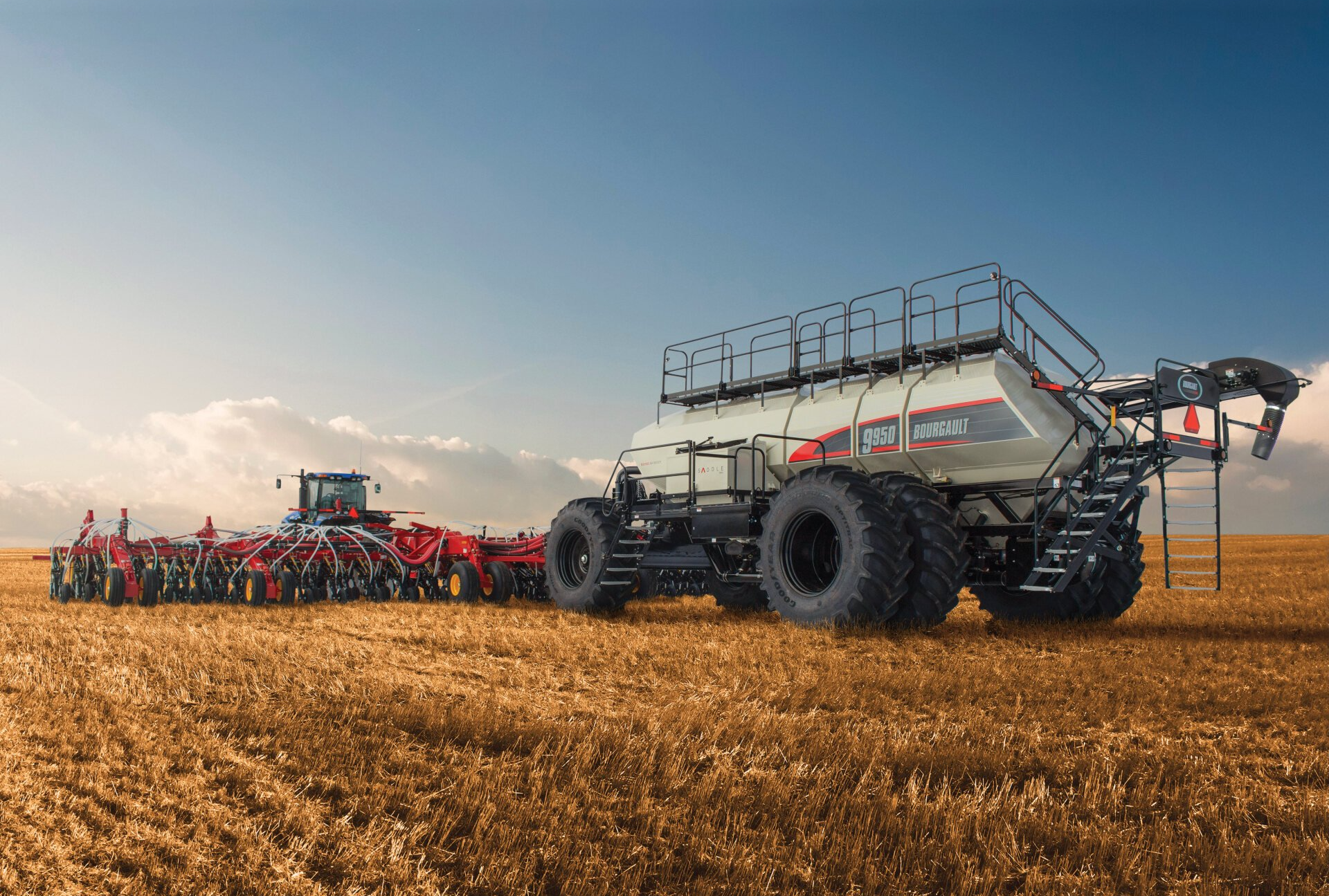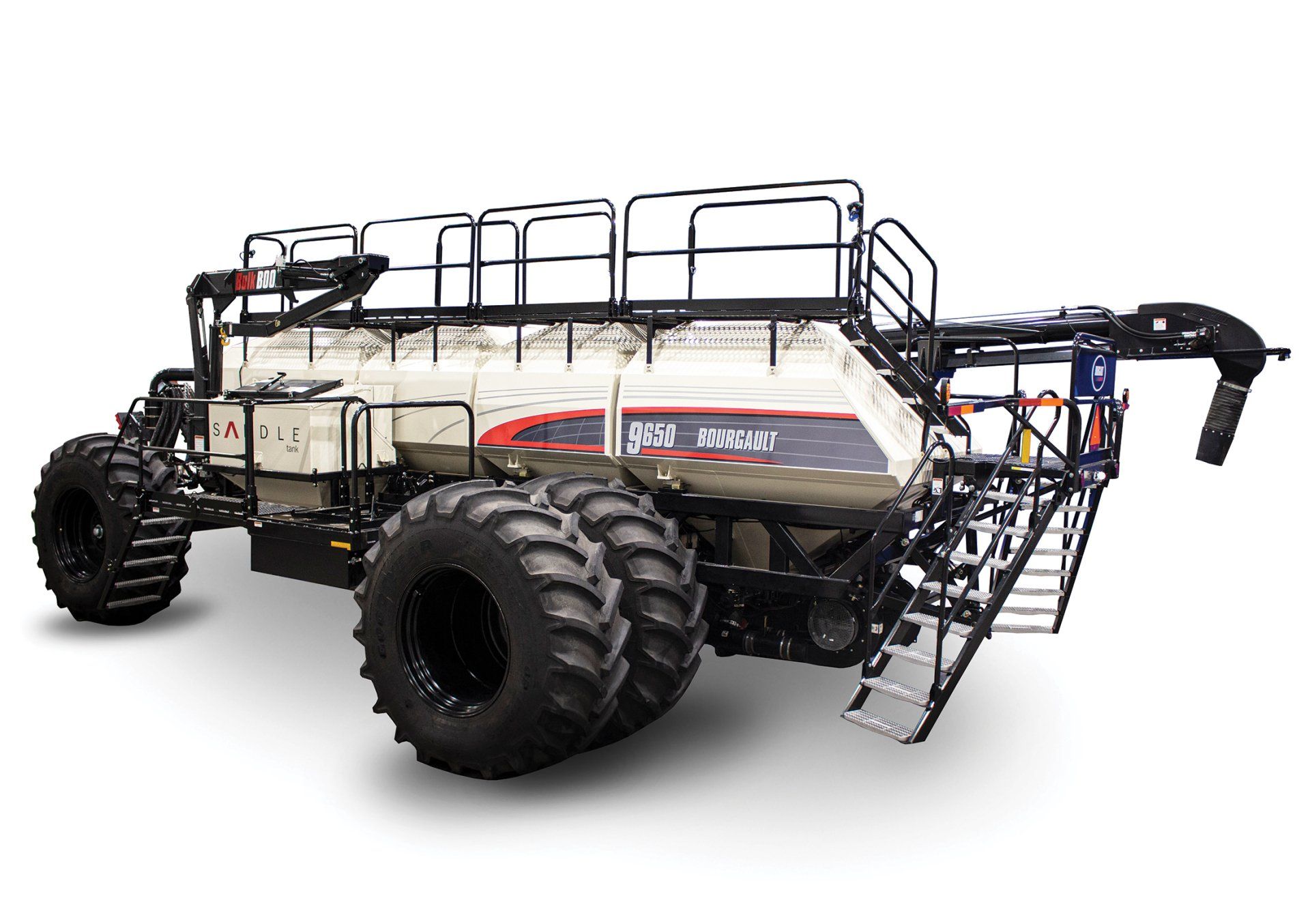1MG FlippingBooks
Innovative air cart a productivity boost for crop growers
Bourgault’s new range of seeding equipment has passed the
test of two seasons in the harsh Australian environment with outstanding results.

The 9000-series air cart, released in Australia in 2021, is “a significant step up in technological capability and builds on multiple patents”, says Ryan O’Sullivan, Bourgault Australia’s Marketing Manager, and an engineer. Allowing Australian farmers to seed quicker and more efficiently, this premium precision product is ideal for crop growers seeking the latest innovations to help get the very best out of every hectare to increase margins.
Significant features include real-time self-calibration functionality, generous tank size to save on refilling time, a reliable metering unit for even seed distribution, and tyre packages to reduce compaction (thereby boosting germination). This advanced agricultural equipment is also very robust so keeps performing for long seasons on hard, dry ground. It can also cope with sodden soils thanks to the option of high-flotation tyres.
Positive feedback from Australian farmers about the 9000-series air cart centres on its high accuracy sowing rate. The equipment has independent tanks with weight scales so the seeder can self-calibrate in real-time.
“You can check the calibrations to ensure the exact amount of seed is going through. It gives farmers the confidence they’re not wasting seed, which is an increasingly expensive input,” says Ryan.
“In previous years, farmers needed to constantly monitor how much product they’d put in a tank and do back-of-the-envelope calculations to ensure the right amount was being used. Now, a lot of those calculations are performed for farmers by the seed rate controller, and it will warn you if it’s not right so you can fix it.”
The machinery comes in a range of sizes right up to 45k-litre, with that version the world’s largest production air cart. That capacity makes the 9000-series ideal for large-scale broadacre cropping sizes, which saves farmers considerable time refilling their tanks. There are also two smaller sizes.
Meanwhile, the base metering unit has stood the test of time for 30 years and, with tweaks, has evolved into a simple, reliable, and accurate unit.
“It uses a horizontal auger to meter products, whereas most other brands will use a roller. Ours have a bigger capacity without the farmer changing metering augers or rollers. Plus, there’s less chance of products jamming”, says Ryan.
“Bourgault’s metering unit has, essentially, one major moving part, and it’s incredibly long wearing, so with minimal upkeep and maintenance, you can keep seeding accurately for a very long time.”
A notable innovation built into the 9000-series air cart is an EvenStream™ Distribution System, which randomizes the seed in the airflow. That means that over an 80-foot-wide seeder bar, the same amount of seed going to the outer edges of the bar is the same as those in the middle. Seeds will germinate evenly, so thin and thick strips are avoided.
Farmers know the air cart is one part of the seeding setup but understanding how it fits the rest of the equipment is essential.
Bourgault has operated in Australia for 25 years. It also sells paralink hoe drills, paralink coulter drills, frame-mounted seeders, mid-row applicators, and air hoe drills. The company distributes through dealership networks and offers a three-year limited warranty.
“We assemble everything in our distribution centres in Perth, Western Australia and Albury, NSW. We also have territory managers on the road supporting the dealership groups and their technicians. So, the first port of call for farmers is their local agricultural equipment dealer,” says Ryan.
That’s where they’ll also be able to access training to use the air cart, which has Topcon controllers. They’re as easy to use as your smartphone, Ryan says. Bourgault also has an extensive online video library for farmers to troubleshoot and deal with any issues.
Ryan is dual-qualified in marketing and mechanical engineering (mechatronics). At Bourgault Australia, 80 per cent of his role is research and development.
“Bourgault’s equipment is very well engineered. Our research and development team invests heavily in designing, testing, and verifying new machines and models before they are released to the market. “
That includes trials right here in Australia.
“Customers are part of our innovation cycle. Our engineers and agronomists work with them on trials to come up with solutions to the problems they see on their farms. For example, Australian farmers from all over the country have helped test several prototypes over the last few years. They gave us feedback so we could improve and further test the machines before they are ready for the market”, says Ryan.
Customisation for the Australian market includes helping deal with the risk of soil compaction during seeding.
“One of the big differences between the equipment used in Australia and overseas is around tyres. We’ve spent much time working on tyre packages and technologies so farmers can run the tyres at extremely low pressure. That will reduce that pressure transferred to the ground. In turn, it will also minimise the negative impact on your soil, so you seeds emerge faster and more evenly,” says Ryan.
“Some of our air carts have tyres that are 1250-millimetres wide on 32-inch rims, meaning they have a big footprint. These high flotation tyre options for the air carts are great for keeping it from getting stuck in the mud.”
The air cart’s ‘Class A’ distribution design means there’s not much componentry in the undercarriage, so if mud flicks up into there, it’s easier to clean and does less damage.
Those insights into how their equipment is used on the ground are the hallmark of Bourgault’s continuous investment in research, development, innovation, and disruption. When asked what air-seeding technology might look like in 10 years, Ryan replies: “We’re pushing the boundaries of what’s possible for air carts to help improve farmer productivity and profitability even more.”
9000 Series video…
https://www.youtube.com/watch?v=Fqr-swJ4Cjk
Website:
https://www.bourgault.com/en-au/products/air-carts/9000-i-series
Email :

















